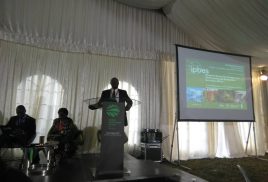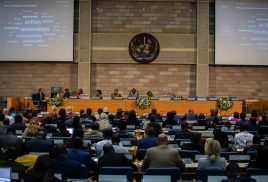We have to know that landscape restoration is an opportunity to transform people’s lives, so we need to know that smallholder farmers should be at the forefront of the whole process.
We must begin to address the societal values that guide us. While climate change and biodiversity loss are some of the greatest challenges of our time, addressing the selfishness and apathy of those responsible for managing our forests is equally important.
A truly integrated approach, bringing together relevant sectors (forestry, agriculture, energy, water) and stakeholders from government, civil society and private sector, will be crucial.
There is a national and global outcry about restoring degraded areas. In the 1980s, Uganda had about 24% forest cover, and currently it’s only 9%.
Africa is the continent with the best landscapes restoration opportunities . Let’s grab them and invest in the restoration of the natural capital of Africa to increase weath and reduce poverty
Africa has pledged to restore 100 million ha by 2030. And we think that communities have a role to play in this. They’ve been working to restore landscapes for decades already.
We wanted to get our forest back to how it used to be. There had been a lot of destruction. We, the indigenous inhabitants of the Mau, realised we could not just sit back and watch people destroy the forest and wait for the Kenya Forest Service to do something.
To restore ecological function, social equity and financial profitability, there must be a combined business case, environmental rationale and social logic.
Global Landscapes Forum Nairobi 2018: As it happened
On August 29-30, 13,380 people tuned in live to the Global Landscapes Forum in Nairobi, Kenya to connect, learn about and share Africa’s successful restoration stories and get inspired to act towards creating sustainable landscapes on the continent. Over the two month campaign period, we received more than 141,000 page views the GLF Nairobi website from 148 countries. Approximately 52,000,000 people were reached on social media, with more than 113,157 likes, comments, retweets and shares around the conversation. #GLFNairobi2018 trended on Twitter for 3 consecutive days during the event. Actors included African officials, international and non-governmental organizations, indigenous communities, finance and the private sector, youth and international artist Rocky Dawuni, all coming together to explore and learn from Africa’s success stories in bringing landscapes back to health.
Were you part of #glfnairobi2018? Tell us what you think and how we can make it even better.
TAKE ME TO SURVEY OUTCOMEEvent highlights
Gender roles and implications for landscape restoration
Rocky Dawuni performs at GLF Nairobi 2018
Bioversity International’s Christopher Kettle on native tree diversity at GLF Nairobi 2018
Lawrence Afere – Why I chose sustainable farming over suit and tie
Global Landscapes Forum Nairobi 2018: The highlights
Restoration of degraded forests in Kenya (Discussion Forum 1)
The Bonn Challenge Barometer: Enabling reporting on action and progress (Discussion Forum 2)
Towards an action agenda on ecosystem restoration for increased resilience in Africa (Discussion Forum 3)
Revitalizing Regional Partnerships and Innovation for Agroforestry Commodity Value Chains in Africa: Lessons from Latin America and East Asia (Discussion Forum 4)
Social inclusion, equity and rights in the context of restoration – lessons from the ground (Discussion Forum 5)
The GLF Nairobi Photo Competition 2018
We received an overwhelming response from photographers from all over Africa: over 400 photos of exceptional quality, diversity, creativity and passion were submitted, collectively proving beyond any doubt the unique beauty of African landscapes and the grassroots determination to defend them.
Have you checked out ThinkLandscape? What about the Knowledge Hub? The GLF is much more than the sum of its events! Dive into the GLF community and discover what it means to #ThinkLandscape.








